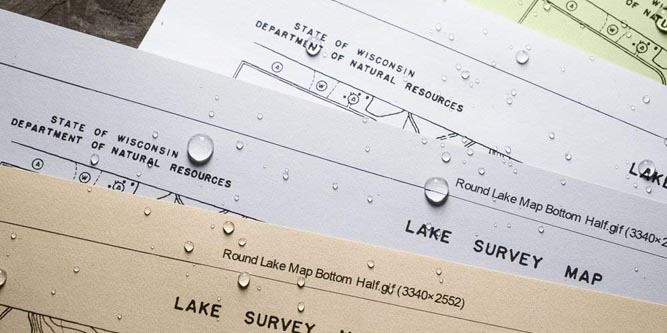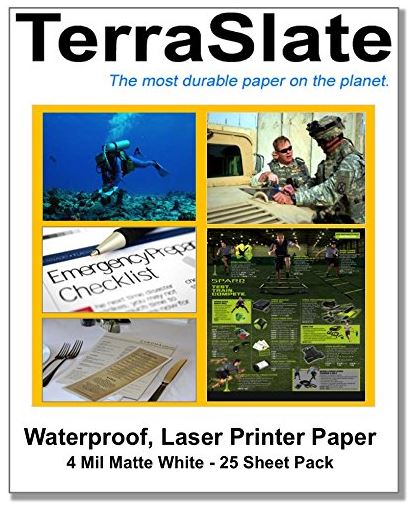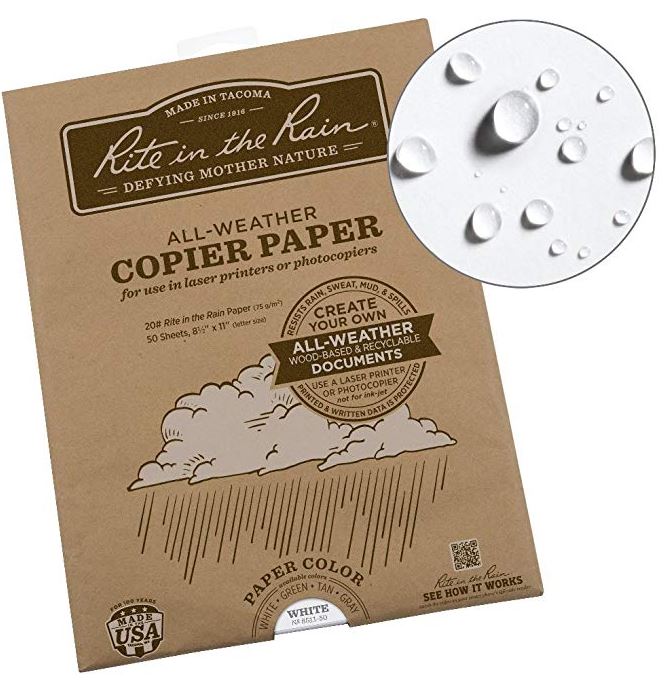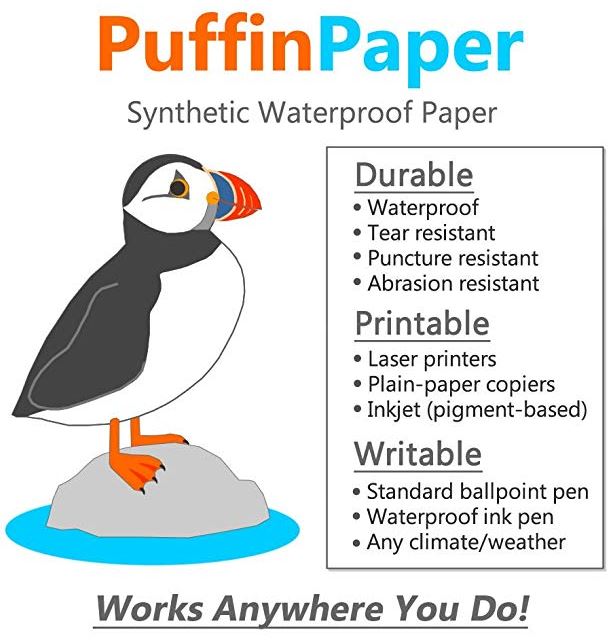Waterproof documents aren’t a one-size fits all phenomenon. People need different types of waterproofing. And sometimes protection from water isn’t the only thing you’re worried about. Depending on what kind of documents you’re printing up, you may want them equipped to handle more than the possibility of a little rain.
Waterproofing your documents is easy, but the reason why it works is somewhat more complicated. Laser printers work by spraying toner particles onto pores within paper, where they become stuck. By contrast, inkjet printers involve the use of dye-based inks that have a particularly unique relationship to water. In short, what you need to know is it’s possible to choose paper that won’t work for you. But finding the right stuff is usually not too difficult when you know what to look for.
Choosing Waterproof Laser Printer Paper
Your selection criteria can be broken into four categories. The first and most important consideration is type of paper. The second is the printing process that you plan on using, including the inks or toners involved. Third, writing implements you may plan on using with the paper, and their compatibility. The fourth and final factor is the environment where your documents will eventually end up in use.
Finding the right waterproof laser printer paper isn’t tough because you’ve already narrowed your selection down to laser printers. That means of your decision comes down to one factor: synthetic or coated? Both synthetic and organic papers are waterproof enough to put them under the faucet, but that doesn’t mean they’re in all ways equal.
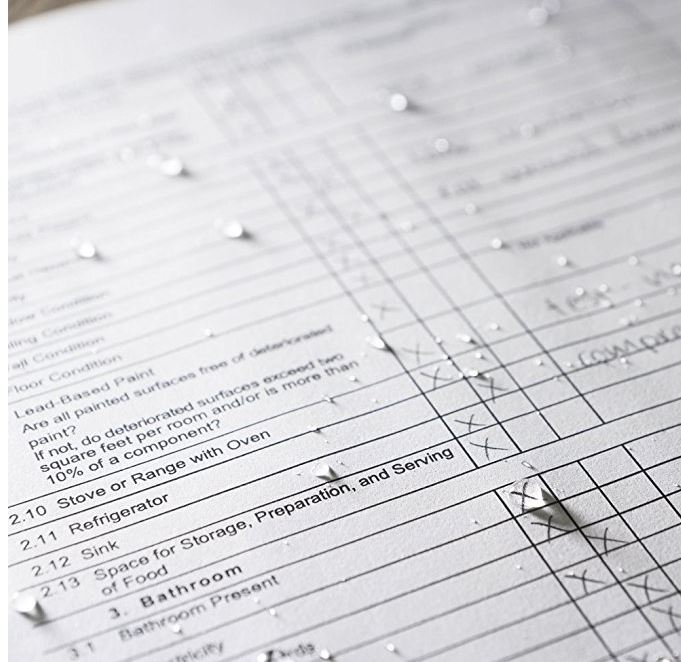
Synthetic vs. Organic
The least expensive option for waterproof laser printer paper is coated paper, which is essentially ordinary office paper that’s been coated for protection against the elements. Organic paper is a good option for shorter-term use. You might use it to post fliers for a lost pet, or to guarantee a higher level of protection to your documents for unpredictable wet environments. But organic paper does have its limits, and will provide essentially no benefits beyond waterproof protection.
Synthetic paper is slightly more expensive because it uses plastics in place of organic tree pulp. Synthetics are then substantially tougher than ordinary paper, and generally make paper look fragile by comparison.
Synthetic paper isn’t a good choice for long-term outdoor use. That’s because the ink will fail long before the paper does, getting destroyed by radiation the sun. Unfortunately, a metal sign is truly the only way to go for long-term outdoor signage. Additionally, synthetic paper shouldn’t be used as menus unless they’ve been laminated. That’s because color from spills and stains would be absorbed by the thirsty paper.
But short of that, a synthetic waterproof paper should be able to hold up to most anything. You’ll want to think about precisely what type of material is being used. Is it soft, rigid, or pliable? Much of this comes down to the thickness of the paper, generally constructed in sizes between 3 and 14 mil.
Added Synthetic Protection
Different pages have different tolerance to heat. The melting point of the toughest synthetics may be 450-degrees Fahrenheit, in parallel with organic paper. But thinner synthetics often have melting points which are closer to 280°F. And most will be constructed of polyester or a softer polyolefin, which has less of an emphasis on heat and more of an emphasis on protection from other sources of damage. For example, general durability, water resistance, tear resistance, and puncture resistance.
Applicability Beyond Laser Prints
You might want your printer paper to be able to work well outside of laser printing. For example, how well does the paper perform with an inkjet printer? How does it hold up against a #2 pencil, or mechanical pencil with extra hard lead? What about writing with pens? There are a variety of applications beyond laser printing which may or may not be possible, depending on the construction of the paper you select.
Regardless of the type of printer you end up using, try to keep in mind it’s best practice to use as little ink or toner as possible on these types of paper. You can usually do this by swapping your printer settings to something like “economy” or “light-print mode.” Additionally, anytime you’re planning a larger project or important work, it may be worth doing field-testing to determine if paper will hold up under extreme circumstances.
TerraSlate Waterproof Laser Printer/Copy Paper
TerraSlate Waterproof Laser Printer Paper packs are available in a variety of different sizes, including 25, 50, 100, 250, 500, and 1,000 sheets. In most instances, synthetic sheets work out to roughly 50-cents per sheet. That’s somewhat of an upfront cost, but it’s capable of paying for itself quickly. TerraSlate paper is totally waterproof and rip-proof, and has been constructed to endure 80-pounds of weight.
Basic Design and Construction
Physically speaking, TerraSlate paper is a cut to standard 11 x 8.5-inch construction. Relative to standard printing sheets, each sheet of TerraSlate waterproof later print paper has a brightness rating of 93, making it floral white. Practically speaking, this paper is relatively invulnerable to chemicals and grease, and mild temperature fluctuations.
Pencil, pen, and even felt-tip pens stick to TerraSlate paper fairly well. There is one exception, however. While you can use a ballpoint pen, the ink may seem somewhat light because the surface of the paper is somewhat slicker than plain paper. That slicker surface causes the ball of the pen to roll a little too easily, and a little too quickly.
Other Considerations
Surprisingly, tape does fairly good at adhering to the surface of TerraSlate waterproof paper, including duct tape. TerraSlate is available in a variety of colors, if you need something beyond standard white. And the #7 construction of its plastic can be recycled with ordinary plastics.
On both sides of the page, TerraSlate laser printer copy paper provides even, steady prints. However, the TerraSlate Waterproof Laster Printer Paper does not support inkjet printers whatsoever.
If your printer runs hot, thin synthetic sheets like these may be prone to slight curling as they come out. If that’s the case with your device, you’ll want to try only printing a dozen synthetic sheets in a row to see if the issue resolves. If not, you’ll either have to switch printers, switch to organic paper, or try a thicker synthetic.
Rite in the Rain Weatherproof Laser Printer Paper
Synthetic paper isn’t for everyone. Rite in the Rain Weatherproof Laser Printer Paper is fairly ordinary printer copier paper, cut and constructed with plain legal paper sizing. It does not have any inkjet support whatsoever, not dye based nor pigment based, so you’ll definitely want to keep it away from inkjets. But for a simple waterproof laser printer paper, you can scarcely do better.
Basic Design and Construction
This 8.5 x 11-inch standard #20 paper is available in a 50-sheet pack, priced about 60% cheaper than full synthetic pages. Those prices do fluctuate if you choose non-standard colors. Rite in the Rain Weatherproof Laser Printer Paper is also available in gray, green, and tan. Those extra colors are a nice choice for adding some contrast to your prints.
In spite of the lacking inkjet support, Rite in the Rain paper supports a wide array of writing implements, including most pens and pencils. The paper is smudge-resistant, which includes resistance to smudging for pencils and pens. But if you really do try your hardest to cause smudges, you can still produce them.
Other Considerations
This paper uses a matte surface luster, reducing its potential for creating glare. It’s a highly economical paper for generally wet environments, and it works exceptionally well in copiers. It’s also completely recyclable as standard paper, which is something that’s not true of synthetic papers. However, Rite in the Rain paper is not tear-resistant or puncture resistant. It has physical consistency that’s closer to that of actual paper. It’s prone to crinkling, and is just as foldable as ordinary paper.
While you can print on both sides, but the results are somewhat sub-par. That’s because for real waterproofing to occur, the ink needs to be able to soak deep into the paper. Double-sided prints are still visible, but you can faintly see the text and images on the other side after a print. That has a slight effect on the presentation of both sides. Unfortunately, it’s difficult to solve that type of problem without switching to synthetic paper.
Puffin Paper Synthetic Waterproof Paper
Puffin Paper is fully synthetic waterproof paper, complete with an anti-glare matte surface. Although modestly expensive among synthetics, Puffin Paper is the gold standard against tears, punctures, chemicals spills, and abrasion. PuffinPaper is available in packs of 25, 50, and 100 sheets. But it’s real variability is in being able to select between two thicknesses. This 10 mil variant is ideal for printing documents on both sides of the sheet. However, it is also available in 8 mil thickness.
Basic Design and Construction
Physically speaking, Puffin Paper uses a standard 8.5 x 11-inch construction. Although Puffin Paper is made specifically for laser printers, it’s often hard to tell. Externally, it seems like ordinary paper copy paper. And it’s quite passable with inkjet printers that use pigment-based inks, though you do have to keep it away from inkjet printers that use dye-based inks.
You can write on Puffin Paper with standard ball point pens, but pencils won’t work. It has modest resistance to smudging on the ink and toner. It’s modestly tear-resistant, but ultimately it’s paper, so it’s not impossible to tear. It’s also puncture resistant, relative to paper. In spite of the fact it’s so sturdy, the both the 8 mil and 10 mil versions of Puffin Paper has excellent folding ability.
Other Considerations
As mentioned, Puffin Paper works fairly well with most ordinary pens. But there is one sticking point. Although ballpoint pens roll rather smoothly, but there is an issue with gel inks. They’re eager to smudge on contact, for similar reasons to why inkjet printers fail on these sheets. You’ll want to keep gel inks away from Puffin Paper.
And at last, if you use a particularly hot printer or copier, these sheets can be prone to slight curling. This is more of a problem for very large, very old, or very active printers. It tends to be more of a concern for the 8 mil variant, but exceptionally hot devices may turn 10 mil pages to curl.
Choosing Between Three Great Waterproof Laser Printer Papers
Rite in the Rain is a great alternative to basic copy paper without going full synthetic. If you’re trying to waterproof fliers, pamphlets, or contracts, Rite in the Rain will help ensure those documents can stand a stream of rain without concern. But it isn’t going to make your paper anymore protected from slashing, punctures, or similar forms of damage. That makes the Rite in the Rain laser printer paper an excellent choice for someone who’s budget-oriented, and really only needs waterproof protection.
Puffin Paper is for laser printers, but it does surprisingly well with inkjets. Not so much that you’d want to expose those inkjet prints to rain intentionally, but it’s nevertheless the most versatile and protection-added synthetic on this list. The slightly thicker 10 mil nature of the paper means it has more depth for soaking ink both sides, which also makes Puffin Paper the right choice for someone who wants to do double-sided laser print jobs.
Finally, there’s TerraSlate Waterproof Laser Printer Paper. Like with Puffin Paper, these synthetic sheets are excellent are resisting virtually all variety of damage. The slightly thinner construction means you won’t want to use it for double-sided prints. But for a fully synthetic paper, it’s a good choice for someone looking for seemingly-ordinary paper that’s been made virtually indestructible.
Meet Ry, “TechGuru,” a 36-year-old technology enthusiast with a deep passion for tech innovations. With extensive experience, he specializes in gaming hardware and software, and has expertise in gadgets, custom PCs, and audio.
Besides writing about tech and reviewing new products, he enjoys traveling, hiking, and photography. Committed to keeping up with the latest industry trends, he aims to guide readers in making informed tech decisions.

